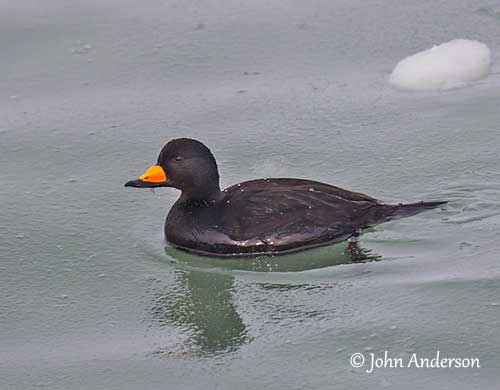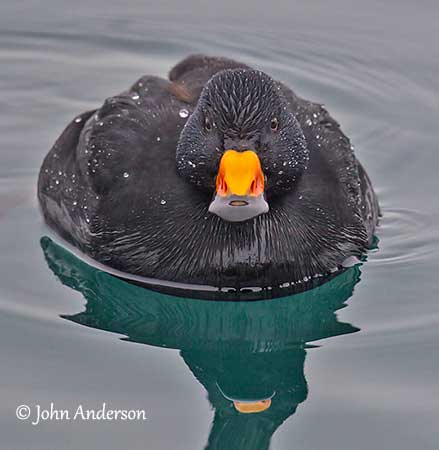
Fr: Macreuse à bec jaune
Ang: Black Scoter
All: Pazifiktrauerente
Esp: Negrón americano
Ita: Orchetto marino americano
Nd: Amerikaanse Zee-eend
Sd: amerikansk sjöorre
Photographers:
John Anderson
John Anderson Photo Galleries
Aurélien Audevard
OUESSANT DIGISCOPING
William Price
PBase-tereksandpiper & Flickr William Price
Text by Nicole Bouglouan
Sources:
HANDBOOK OF THE BIRDS OF THE WORLD vol 1 by Josep del Hoyo-Andrew Elliot-Jordi Sargatal - Lynx Edicions - ISBN: 8487334105
GUIDE DES CANARDS, DES OIES ET DES CYGNES – de Steve Madge - Delachaux et Niestlé - ISBN: 2603013769
All About Birds (Cornell Lab of Ornithology)
The Birds of North America online
Biodiversity of the Central Coast
What Bird-The ultimate Bird Guide (Mitchell Waite)
Wikipedia, the free encyclopaedia
Black Scoter
Melanitta americana
Anseriformes Order – Anatidae Family
INTRODUCTION:
The Black Scoter is very similar to the Common Scoter (M. nigra) but the latter is an Old World species. Only males show some morphological differences, and especially bill and head patterns.
The Black Scoter breeds in the far North America and on the Siberian side of the Bering Sea. It winters southwards in temperate regions.
This aquatic species feeds on molluscs, crustaceans and small fish caught by diving. It nests on the ground among the vegetation, and sometimes far from water.
The Black Scoter is vulnerable to oil spills during the moulting period and the winter. Degradation of food resources due to oil exploration and disturbance also affect this species currently listed as Near Threatened.

DESCRIPTION OF THE BIRD:
Biometrics:
Length: 43-54 cm
Wingspan: 79-90 cm
Weight: 860-1087 g
The Black Scoter adult male has black plumage overall with violet-blue gloss above except for the flight-feathers.
The black underparts are glossed green. On the underwing, the coverts are black, whereas the flight-feathers show pale inner webs.
The bill is black with yellow-orange knob on upper mandible, but tip and edges are black. The eyes are dark brown. Legs and feet are blackish.
The adult female is dark brown with pale cheek patch and dark crown.
The bill is dark brown to blackish with variable amounts of yellow. The eyes are yellow-brown to brown. Legs and feet are brownish to black.
Male and female retain the same plumage year-round.
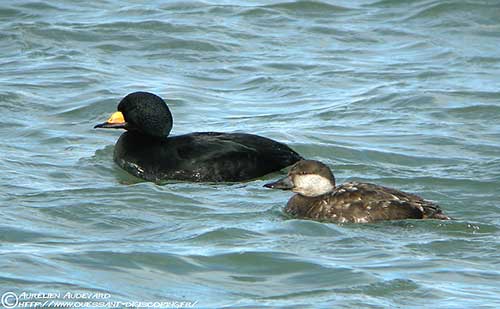
The juvenile is paler than female, especially on underparts and lower part of head. The young male gets the basal knob on the bill through the second winter.
RANGE:
The Black Scoter of eastern populations breeds in N Quebec, Labrador and W of Great Slave Lake, whereas the western population breeds in NC Alaska Peninsula, Bristol Bay Lowlands, Yukon-Kuskokwim Delta and Kotzebue Sound. It also breeds from R Yana in Siberia.
It winters along the Atlantic coast from Nova Scotia S into Florida, with high concentrations along New Jersey and Massachusetts coasts. Small populations winter in the Great lakes.
They also winter along the Pacific coasts from Aleutian Islands to mid-California, but numerous birds winter in the Aleutians and along Alaska Peninsula.
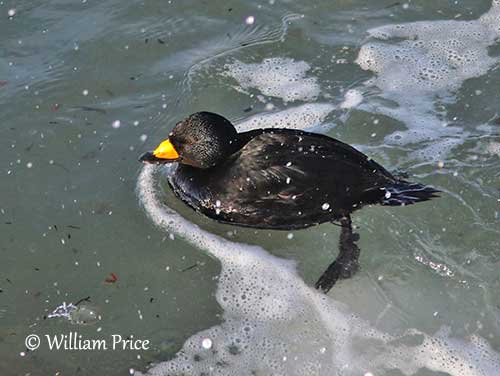
HABITAT:
The Black Scoter breeds in low-lying wet tundra and higher slopes in open areas, and around lakes in northern forest. It usually breeds near shallow tundra lakes in Alaska, or boreal forest lakes in E and C Canada.
The Black Scoter winters in bays and estuarine areas, and along exposed coastlines.
CALLS AND SONGS: SOUNDS BY XENO-CANTO
The Black Scoter is usually fairly silent, but it becomes more vocal during the breeding season. During the courtship displays, the male utters a single note of almost 0,7 second in duration and rising slightly, described as a mournful, constant mellow, plaintive whistling sound “whuuuuw” or “huuwuw”. The female utters low growling sounds in courtship. This species is more vocal than other scoters.
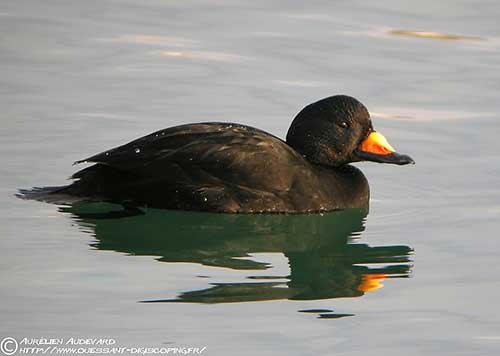
BEHAVIOUR IN THE WILD:
At sea, the Black Scoter feeds primarily on molluscs, mainly mussels and various other bivalves, crustaceans, marine worms and echinoderms.
During summer in fresh water lakes, it takes mostly aquatic insects, fish eggs, molluscs, small fish and probably some vegetal material such as pondweeds.
The Black Scoter dives and swims underwater, propelled by its webbed feet. It dives in depths < 10 metres to catch a prey which is swallowed whole. The shell is crushed by the powerful muscles of the gizzard.
At the beginning of the breeding season, several males usually court one female and swim around her. The male displays by rushing along water surface with hunched back and lowered head. It bows jerkily while the tail is raised vertically over its back. This display is accompanied by calling.
The pair forms in winter and the male deserts the female soon after incubation starts.
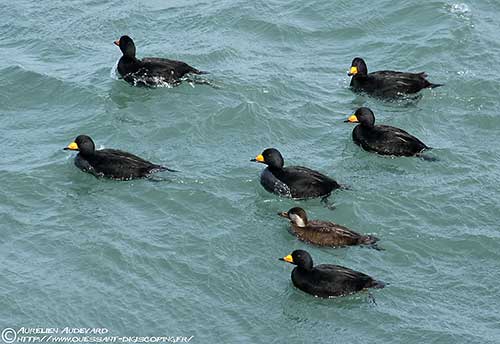
The Black Scoter starts the spring migration in April, and arrives on the breeding grounds in mid-May/early June.
The moult occurs in July and August, and extends to late August/September for successful hens. The birds become flightless during 3-4 weeks.
The fall migration starts in early September and into November.
The Black Scoter has strong, direct flight with powerful, rapid wingbeats. The wings produce a whistling noise during the flight.
REPRODUCTION OF THIS SPECIES:
The breeding season starts in May/June. The Black Scoter nests in single pairs. The nest is on the ground and often near water. It is a shallow depression usually lined with plant material and down. It is built by the female on a hummock or ridge on tundra protected by grasses or low scrub, or hidden in a rock crevice.
The female lays 5-11, usually 6-8 whitish to pale buff eggs. She incubates alone during 27-31 days. The chicks are covered with down. They leave the nest soon after hatching and go to the water. The female broods them during the first nights. She tends them but they are able to feed themselves. They fledge 6-7 weeks after hatching. This species produces a single brood per season.
PROTECTION / THREATS / STATUS:
The Black Scoter is vulnerable in winter and during the moulting period to oil spills, human disturbance and degradation of food resources by both oil exploration and commercial exploitation of benthic shellfish.
The global population is estimated to number 530,000/830,000 individuals, with about 2/3 of mature birds.
The Black Scoter is currently listed as Near Threatened.
